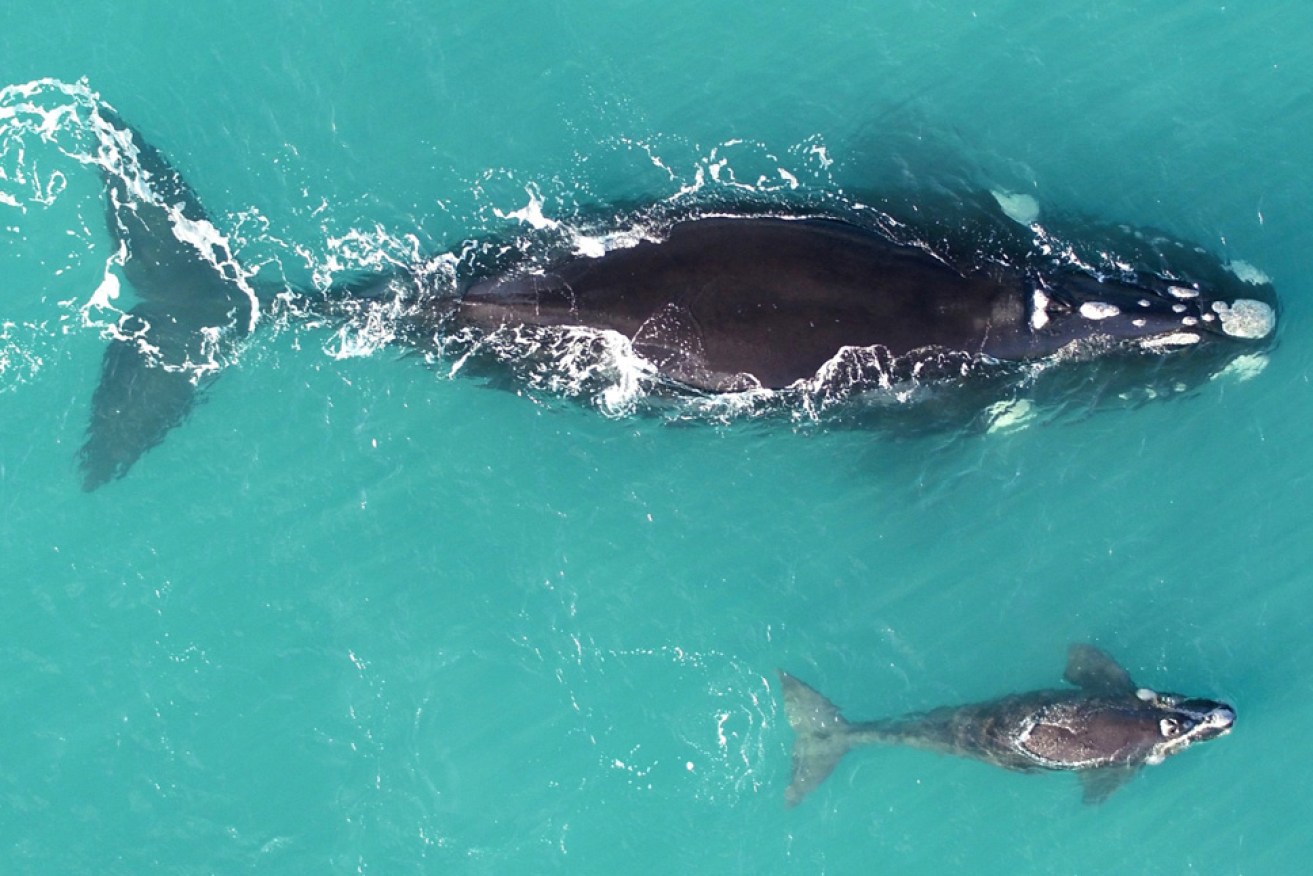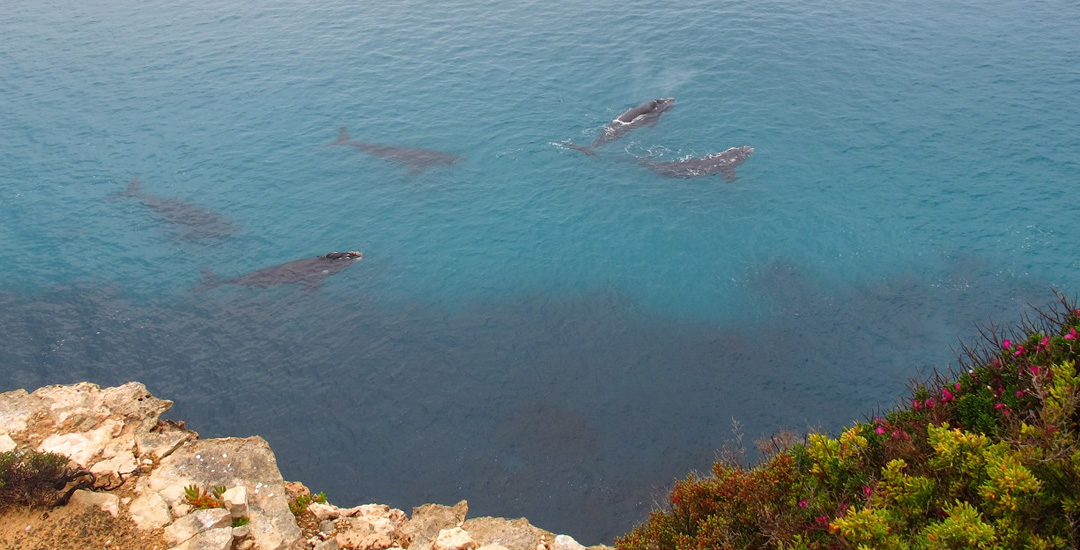Whale baby boom confirms southern right recovery
Australia’s southern right whale population has reached its highest point in more than a century, with record numbers sighted this year at the calving ground at Head of Bight in South Australia.


Whales head to the sheltered waters at Head of Bight in May and stay until October. Photo: F Christiansen, Murdoch University Cetacean Research Unit
A team of researchers from Curtin University, led by PhD candidates Claire Charlton and Rhianne Ward, have been at Head of Bight on the edge of the remote Nullarbor Plain since mid-June and have counted up to 172 whales, including 81 mothers with calves on a single day. It is the highest figure since data collection began in 1991 at what is Australia’s biggest southern right calving ground.
Great Australian Bight Right Whale Study lead researcher Claire Charlton said the record numbers were consistent with the 7 per cent growth rate since southern right whales were almost wiped out by commercial whaling in Australia from 1820 to 1935.
“We’re having a great season,” she said.
“We had a really low year last year so we expected to have a good year this year to make up for that.
“While the numbers are high this year and it is a good sign of the increase in the population, it’s still important to note that these animals are still listed as endangered and their numbers are very low compared to what they were pre-whaling.”
The survey findings were confirmed by a recent Western Australian Museum aerial survey of the area, which counted similar numbers.
The Curtin University researchers from the Centre for Marine Science and Technology are also joining forces with researchers from Murdoch University’s Cetacean Research Unit on the project.
Led by Dr Fredrik Christiansen, the Murdoch University researchers are using drones for the first time to take photos of the whales to help with health checks and identification.
“The quality of the images is fantastic and it’s a really good use of technology to collect the photo IDs of the animals as well as using the images to actually calculate the size and the health of the whales,” Charlton said.
“We also use microphones to monitor all the underwater sounds of the ocean including the acoustics of the southern right whales and the humpback whales in the area.”
Charlton said although whaling of southern rights was outlawed in 1935, continued illegal whaling for many years delayed the species’ recovery.
“There were less than 300 southern right whales in the whole world and it’s only since the 1970s and ’80s that we’ve seen the whales even return to Australian waters,” she said.
There are an estimated 12,000 southern right whales in the world with sub species in Australia, New Zealand, Argentina and South Africa. About 100,000 southern rights cruised the oceans before whaling but more than 75 per cent of them were slaughtered by 1845.
The whales spend the summer months in Antarctic waters feeding up on krill. Expecting mothers migrate to the warmer, sheltered waters at Head of Bight in May and stay until October.
Females give birth every three to four years and reach sexual maturity at nine years of age. Adults can grow up to 18 metres long, weigh 80 tonnes and are believed to live for about 80 years.
“What we end up seeing is variation in the numbers at the site each year, which is what makes it critical for us to monitor them every year so we can actually monitor their cohort and see how the population increases over time,” Charlton said.
“We look at distribution, abundance, site use, how many whales there are, how often they return.
“A lot of them only return every three or four years. Because our study’s been going for 26 years, we have animals that were first sighted with a calf in 1991 … we’ve got animals who have had nine calves here.”
The research is being conducted on Yalata Aboriginal Lands with sponsorship from Santos and Murphy and support from Aboriginal Lands Trust and Fowlers Bay Eco Tours.
Despite its remote location – 1100km west of Adelaide – the Head of Bight Visitor Centre has been inundated with about 250 whale watchers a day.

Photo courtesy of Curtin University Great Australian Bight Right Whale Study.
Charlton said the 55m-high Bunda Cliffs overlooking Head of Bight made for an ideal vantage point to watch the whales.
“A lot of people travel here to see the whales but it also just shows how many people are crossing the Nullarbor. A lot of people are caravanners or Grey Nomads cruising around and coming for a look.
“The whales come very close to shore – usually within a few hundred metres and sometimes as close as 60 metres.”
Its shallow, sandy bottom, protection from wind and its location within the Great Australian Bight Marine Park has helped Head of Bight become one of the largest southern right calving areas in the world.
“The sanctuary zone here is really doing a good job of providing the protection that the whales need, which also encourages other animals into the area,” Charlton said.
“There’s a full vessel closure in whale season and a total exclusion zone – it’s something we should be really proud of here.”
South Australian Museum senior mammal researcher Cath Kemper said the remote area, which was difficult to access for shore-based whalers, was thought to have been a popular spot for southern rights for centuries.
“Right whales in their migratory routes and calving have amazing memories that are passed down from one generation to the next, so we believe,” she said.
A BP proposal to drill for oil about 200km offshore from Head of Bight has sparked environmental concerns and prompted a visit to the area by marine activist group Sea Shepherd last month.
Charlton said boat traffic, noise and the potential for an oil spill were the primary factors that could influence the whales
“Most certainly they need consideration because we know that the development is in an area that is significant to the whales,” she said.
This article was first published on The Lead.




